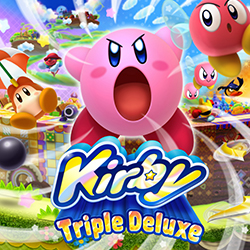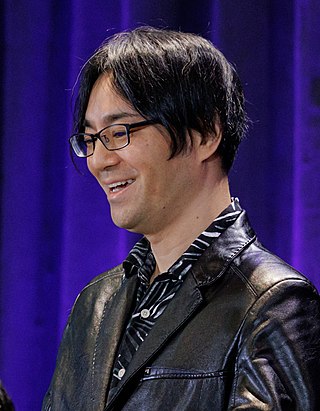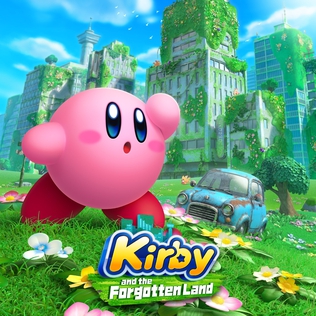
Kirby is the titular character and protagonist of the Kirby series of video games owned by Nintendo and HAL Laboratory. He first appeared in Kirby's Dream Land (1992), a platform game for the Game Boy. Since then, Kirby has appeared in over 50 games, ranging from action platformers to puzzle, racing, and even pinball, and has been featured as a playable character in every installment of the Super Smash Bros. series (1999–present). He has also starred in his own anime and manga series. Since 1999, he has been voiced by Makiko Ohmoto.

Kirby's Adventure is a 1993 platform game developed by HAL Laboratory and published by Nintendo for the Nintendo Entertainment System (NES). It is the second game in the Kirby series after Kirby's Dream Land (1992) on the Game Boy and the first to include the Copy Ability, which allows the main character Kirby to gain new powers by eating certain enemies. The game centers around Kirby traveling across Dream Land to repair the Star Rod after King Dedede breaks it apart and gives the pieces to his minions.

Kirby Super Star, released as Kirby's Fun Pak in PAL regions, is an anthology platform video game developed by HAL Laboratory and published by Nintendo for the Super Nintendo Entertainment System in 1996. It is part of the Kirby series of video games by HAL Laboratory. The game was advertised as a compilation featuring eight games: seven short subsections with the same basic gameplay, and two minigames.

Meta Knight is a fictional character and antihero in Nintendo's Kirby video game series created by Masahiro Sakurai and developed by HAL Laboratory. He first appeared in the 1993 video game Kirby's Adventure as a nameless character, remaining unnamed until the game Kirby's Avalanche. The character also appears in several Kirby comic books, in the 2001 anime series, and as a playable character in the Super Smash Bros. series.

Kirby: Squeak Squad, known in Europe as Kirby: Mouse Attack, is a platform video game developed by HAL Laboratory and Flagship and published by Nintendo for the Nintendo DS. It is one of the mainline installment entries of the Kirby series and the second Kirby game released for the system. The game was released in Japan and North America in 2006 and in Europe, Australia, and South Korea in 2007. The game was later re-released for the Wii U's Virtual Console on June 25, 2015.
This is a list of characters from the Kirby franchise, who are featured in video games and other media across the franchise.

Kirby is an action-platform video game series developed by HAL Laboratory and published by Nintendo. The series centers around the adventures of a bubblegum pink round hero named Kirby as he fights to protect and save his home on the distant Planet Popstar from a variety of threats. The majority of the games in the series are side-scrolling platformers with puzzle-solving and beat 'em up elements. Kirby has the ability to inhale enemies and objects into his mouth, spitting them out as a projectile or eating them. If he inhales certain enemies, he can gain the powers or properties of that enemy manifesting as a new weapon or power-up called a Copy Ability. The series is intended to be easy to pick up and play even for people unfamiliar with action games, while at the same time offering additional challenge and depth for more experienced players to come back to.

Kirby Super Star Ultra is an anthology platform video game developed by HAL Laboratory and published by Nintendo for the Nintendo DS in 2008. The game is an enhanced remake of Kirby Super Star, originally released for the Super Nintendo Entertainment System in 1996, to commemorate the Kirby series' 15th anniversary. The remake retains all game modes found in the original, and adds four major new ones, along with adding updated visuals and full-motion video cutscenes.

Kirby's Return to Dream Land is a 2011 platform video game developed by HAL Laboratory and published by Nintendo for the Wii. It is the ninth mainline installment and the twenty-second game in the Kirby series. The game's plot follows Kirby, King Dedede, Meta Knight, and Bandana Waddle Dee as they help an alien named Magolor recover the pieces of the Lor Starcutter so he can return home. While Kirby's Epic Yarn was released in 2010, Kirby's Return to Dream Land is the first traditional Kirby platforming home console game since Kirby 64: The Crystal Shards, which was released in 2000 for the Nintendo 64. The title was released in North America on October 24, 2011, in Japan on October 27, 2011, in Europe on November 25, 2011, and in Australia on December 1, 2011.

Kirby's Epic Yarn is a platform game developed by Good-Feel and published by Nintendo for the Wii. It is an installment of the Kirby series and was released in October 2010 in Japan and North America and in February 2011 in Australia and Europe. It is the first entry in the Kirby series on a home video game console since 2003's Kirby Air Ride for the GameCube, and its first home console platform game since 2000's Kirby 64: The Crystal Shards for the Nintendo 64.

Kirby: Right Back at Ya!, known in Japan as Kirby of the Stars, is a Japanese anime series based on Nintendo's Kirby franchise. Produced by Chubu-Nippon Broadcasting, Dentsu, A-UN Entertainment and Studio Sign, it was directed by Sōji Yoshikawa and Mitsuo Kusakabe, with Yoshikawa handling series composition, Miyuki Shimabukuro designing the characters, Kazuo Iimura serving as chief animation director, and Akira Miyagawa composing the music. The series ran for one hundred episodes on CBC and TBS, from October 2001 to September 2003 in Japan. In the United States, the show aired on Fox Box, beginning in September 2002. Episodes have also been released on the Kirby TV Channel for the Wii game console, and on the game compilation Kirby's Dream Collection.

Kirby: Triple Deluxe is the thirteenth platform and tenth mainline installment of the Kirby video game series, developed by HAL Laboratory and published by Nintendo for the Nintendo 3DS. The game was released in Japan on January 11, 2014, in North America on May 2, 2014, in Europe on May 16, 2014, and in Australia on May 17, 2014. The game follows Kirby as he embarks on a journey through six worlds to rescue King Dedede from Taranza.
Amiibo is a toys-to-life platform by Nintendo, which was launched in November 2014. It consists of a wireless communications and storage protocol for connecting figurines to the Wii U, Nintendo 3DS, and Nintendo Switch video game consoles. These figurines are similar in form and functionality to that of the Skylanders, Disney Infinity and Lego Dimensions series of toys-to-life platforms. The Amiibo platform was preannounced to potentially accommodate any form of toy, specifically including general plans for future card games. Amiibo use near field communication (NFC) to interact with supported video game software, potentially allowing data to be transferred in and out of games and across multiple platforms.

Kirby and the Rainbow Curse, known in PAL regions as Kirby and the Rainbow Paintbrush, is a platforming video game in the Kirby series, developed by HAL Laboratory and published by Nintendo for Wii U. The title, which is a follow-up game of the 2005 Nintendo DS title Kirby: Canvas Curse, was released by Nintendo on January 22, 2015, in Japan, February 20, 2015, in North America, May 8, 2015, in Europe, and May 9, 2015, in Australia. The game supports the Kirby, Meta Knight, and King Dedede Amiibo.

Kirby Star Allies is a 2018 platform video game developed by HAL Laboratory and published by Nintendo for the Nintendo Switch. It is the twelfth mainline installment in the Kirby series, the player controls Kirby in his quest to prevent a priest named Hyness from reviving a dark force to destroy the universe. Kirby must complete each level by jumping, inhaling enemies, and using his array of abilities to progress.

Kirby Battle Royale is a brawler multiplayer video game in the Kirby series. Developed by HAL Laboratory and published by Nintendo, the game was released on the Nintendo 3DS handheld game console in Europe and Japan in November 2017, and in North America in January 2018.

Shinya Kumazaki is a Japanese video game director, game designer, HAL Laboratory employee, and painter who is the current general director of the Kirby series and voice of King Dedede.

Kirby Fighters 2 is a 2020 fighting game for the Nintendo Switch and is the direct sequel to Kirby Fighters Deluxe. Developed by HAL Laboratory and Vanpool and published by Nintendo, the game features characters and assets from the Kirby franchise and uses the Super Kirby Clash game engine. The game released worldwide in September 2020, but was accidentally leaked prior on the Play Nintendo website.

Kirby and the Forgotten Land is a 2022 platform video game developed by HAL Laboratory and published by Nintendo for the Nintendo Switch. It is the thirteenth mainline installment in the Kirby series, as well as the first game in the series in full 3D, excluding spin-offs. The player controls Kirby in an adventure through the titular forgotten land called the New World to rescue Waddle Dees kidnapped by the ferocious Beast Pack. To complete each stage to save the Waddle Dees, Kirby can use a wide range of copy abilities to help battle enemies and progress.
















